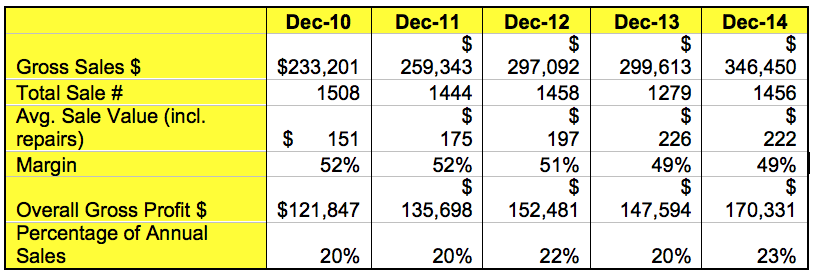MOST JEWELERS will be smiling with glee after a healthy December’s trading brought an end to 2014.
Our comparative data shows the average store achieved sales of $346,350 in December, up from $299,613 in the same month in 2013. At 15 percent, this is the biggest single jump in December sales we have seen since first measuring our data back in 2008 and as the table below shows, continues the upward trend that most stores have been experiencing for the last few years.

As can also be seen from the table, sales have steadily climbed for the last few Decembers from a low of $233,201 to a current level of $346,450, an overall increase of 48 percent. Of interest is the drop in margins which have fallen from 52 percent in 2010 to a level of 49 percent now. This is not what we would expect to see – normally stronger trading conditions put less pressure on margins but the opposite seems to be the case. Delving into the numbers further though shows a strong increase in average sale from $151 to $222 (up 47 percent) and a reduction in quantity sold from 1,508 items to 1,456. Simply put, stores are selling higher priced items to fewer people and these higher priced items carry a lower markup.
So what does this mean for profit? Gross profit has increased on average by $48,484 from $121,847 to $170,331. Does that improve the bottom line correspondingly? Most businesses will have seen some increased costs over the 4-year period, but this shouldn’t be more than the cost of living. The lower sales volume suggests most stores should be employing the same level of staffing to achieve these numbers, meaning most of the $48,484 gross profit increase in December should be going to the bottom line.
So how do your numbers compare?
Advertisement
Review your store sales, average sale, quantity and gross profit for December against the same month in 2013. Are the numbers up or down? If you have increased sales have you increased gross profit? If so, has it transferred into more money in your bank account?
It’s easy to get fixated on sales as the main driver of your business. Looking at your gross profit is important too, but if your costs are increasing by more than your gross profit then you will have nothing to show for your improved sales effort. Even if you control your expenses but have a wandering eye when it comes to buying new inventory then your cash flow will not improve and at some point you need this to happen.
A jewelry store should be a cash cow. You not only should make a profit on paper but you should make a profit in the bank. If your sales are increasing but your bank account isn’t then look at the following:
- Have you reduced your margins?
- Have you increased your expenses?
- Are you withdrawing too much from the business for personal reasons?
- Are you reinvesting money into assets (e.g. inventory, debtors) that aren’t increasing your business returns or creating you more business?
Chances are if sales aren’t turning into cash it will be one of these areas that are letting you down. Compare your results and pinpoint where the money is gone. It’s your money – you need to know what’s happened to it.